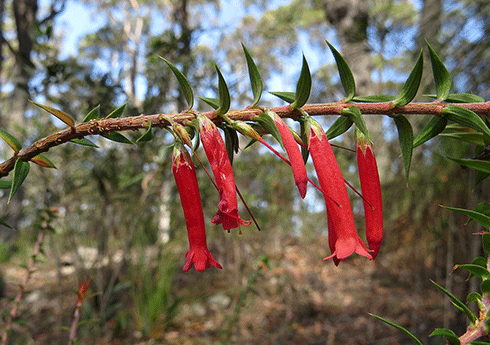
|
Published: 16 June 2014
Changing rainfall patterns influencing plant growth and fruit development
The impact of changing annual rainfall patterns on plant growth worldwide as a result of global warming will vary greatly across regions, according to new study.

|
|
Common Heath, Epacris impressa, in flower, Deua National Park, NSW, Australia. Credit: John Tann
|
Despite the fact we are seeing more intense droughts, storms and floods associated with climate change, we don’t currently know how many plants, particularly deep-rooted trees, will respond to changes in timing of precipitation.
Dr Melanie Zeppel and Ms Jessica Wilks of Macquarie University in collaboration with Professor James Lewis of Fordham University, New York, investigated the impacts of extreme precipitation events, such as floods and droughts, on a variety of plants including grasses and crops, and on tree rooting depths.
They conducted a review of how plants respond to extreme precipitation in different ecosystems around the planet (dry grasslands, woodlands, warm humid tropical rainforests, savannas, cold deserts, etc).
Their results showed that soil water content influences both plant growth and plant interactions with pests, pathogens and invasive species. Depending on the region and soil type, changed moisture levels may also alter the carbon and water cycles of an area.
These changes will have far-reaching implications for food production, forest industries and biodiversity.
In the paper, published in Biogeosciences, Dr Zeppel says that seasonal changes to rainfall ‘may have significant effects on plant water stress and growth rates.’
‘Knowledge of how plants respond to extreme precipitation is essential to understanding plant responses to future climates. This inspired us to examine the current state of knowledge.
‘CSIRO and the Intergovernmental Panel on Climate Change (IPCC) agree that in future we are likely to experience more extreme weather, with many regions receiving intense droughts, floods, as well as hotter heat waves and bush fires.
‘Even if the amount of rainfall within a year stays the same, in future, rain is likely to fall in more intense and “extreme” rain events. That means rather than many, small rain events, we are likely to experience, fewer, more heavy rain events.
‘Precipitation may also shift seasons, for example, with more falling in autumn, and less falling in spring.’
Source: Macquarie University



